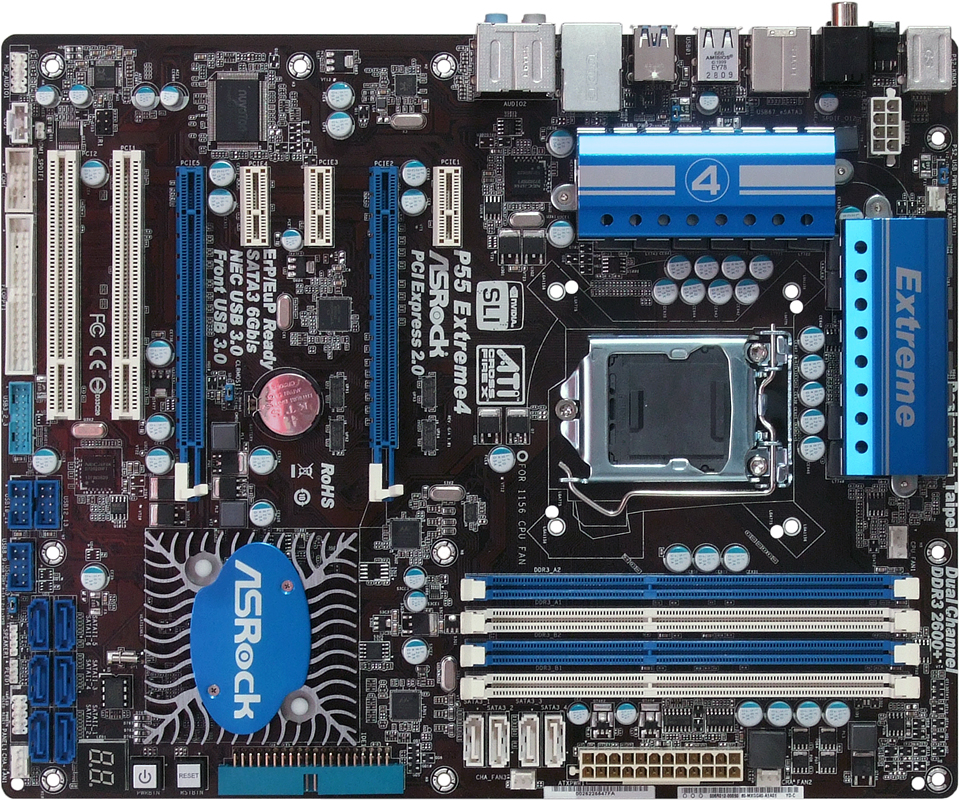USB 3.0 To The Front Panel: ASRock Leads The Way
ASRock was the first company to respond to our impassioned pleas for a front-panel USB 3.0 connector. As other companies attempt to catch up, we examine the boards that started it all to see if the implementation maintains full USB 3.0-class performance.
LGA 1156: ASRock P55 Extreme4
Intel doesn’t support SATA 6Gb/s, but that doesn’t mean ASRock can’t add it. The P55 Extreme4 includes an impressive array of dual SATA 6Gb/s and dual USB 3.0 controllers, in spite of Intel’s unfortunate chipset restrictions.
Those restrictions handicap many of this board’s key features. The LGA 1156 platform gets all of its PCIe 2.0 pathways from the CPU, and there are only sixteen of these, all devoted to two graphics card slots in x16 mode (single card) or x8 mode (two cards).
The P55 Express PCH has eight PCIe pathways that are labeled as version 2.0, but provide only version 1.1 signaling rates. Every x1 device connected to those pathways is thus restricted to 2.5 Gb/s, or half of the PCIe 2.0 specification. That includes two SATA 6Gb/s controllers that connect to the motherboard at a lower data rate than even the chipset’s native SATA 3Gb/s ports.
Other shared items include an eSATA connector that steals its port from internal SATA 6Gb/s, reducing available SATA 6Gb/s ports from four to three. Yet, internal drives should at least be able to communicate with each other at rates higher than that of a single PCIe 1.1 lane, so long as the drives are connected to the same controller.
The rear panel and front panel get separate NEC D720200F1 controllers, each restricted to 2.5 Gb/s bandwidth shared between its two ports as a result of Intel’s chipset design. That’s still far superior to the 0.5 Gb/s bandwidth available through USB 2.0, however.
Get Tom's Hardware's best news and in-depth reviews, straight to your inbox.
Current page: LGA 1156: ASRock P55 Extreme4
Prev Page 890FX Deluxe4 BIOS, Overclocking And Accessories Next Page P55 Extreme4 BIOS, Overclocking And Accessories-
Thank you ASRock for bringing USB3.0 front header on your motherboards! Now i can expect a much nicer set-up in my case in an upcoming build...Reply
-
Crashman razor512Now all they need to do is lead the way with a standardized case connector.darthvidorI sure hope the standard connector comes out before this gets out of hand.You're looking at it, Page 1 photo. Other motherboard manufacturers are already using this same connector as mentioned in the article, so it should only be a matter of a few months before case manufacturers follow suit.Reply -
ASRock responds to pleas? Maybe someone could plead for dual-gigabit-ethernet equipped SOC-chipped (atom? i3?) 6x sata2 motherboards, too. It's impossible to build your one-machine-to-rule them all firewall-server-htpc in a small form factor currently!Reply
-
liquidsnake718 Yeah i remember reading reports that Intel dithed USB 3.0 about 6 months ago in favor of the mb and new CPU research (P66, 67). Surprisingly they sold this tech or the design to ASROCK. Im sure they will eventually come around to implimenting this for ALL future motherboards.Reply
So would old cases be able to use this since it is just a connector?
-
Crashman liquidsnake718Yeah i remember reading reports that Intel dithed USB 3.0 about 6 months ago in favor of the mb and new CPU research (P66, 67). Surprisingly they sold this tech or the design to ASROCK. Im sure they will eventually come around to implimenting this for ALL future motherboards. So would old cases be able to use this since it is just a connector?Revised cases could use it, if they had the new cable and connector. Remember that USB 2.0 and USB 3.0 are not cross-compatible, they use separate signal pins and share only power and ground with each other.Reply -
mauller07 They should have kept the board like the 890gx extreme 3 without all the legacy rubbish like floppy or pata, when looking at the boar layouts in comparison this extreme 4 just looks messyReply


